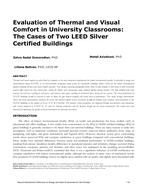Description
Thermal and visual comfort are often listed by occupants as the most important requirements for indoor environmental quality. Leadership in energy and environmental design (LEED), as an internationally recognized rating system for sustainable buildings, defines credits for the indoor environmental quality including thermal and visual comfort qualities. New designs, pursuing daylighting credits, draw on high window to wall ratios in order to provide natural light, which has also caused glare, closing the blinds, and consequently using artificial lighting during daytime. The high window/wall ratio increases the heat loss, resulting in cold spaces, and increases solar gains, resulting in overheated spaces during the hot seasons. The actual performance of LEED buildings should be assessed in order to define the gap between designed and actual levels of performance. This study, through questionnaire survey and onsite measurement, evaluates the visual and thermal comfort in four classrooms of different window sizes, locations, and orientations in two LEED buildings on the campus of Texas A & M University. The students’ actual perceptions are compared through measurements and simulations with metrics proposed in LEED v2, v3, and v4, showing satisfaction wih the thermal, though not the visual environment. The results have been discussed for improving the quality of visual environment in university classrooms.
Citation: Second International Conference on Energy and Indoor Environment for Hot Climates, Doha, Qatar, February 2017
Product Details
- Published:
- 2017
- Number of Pages:
- 8
- Units of Measure:
- Dual
- File Size:
- 1 file , 2 MB
- Product Code(s):
- D-HCC17-15




